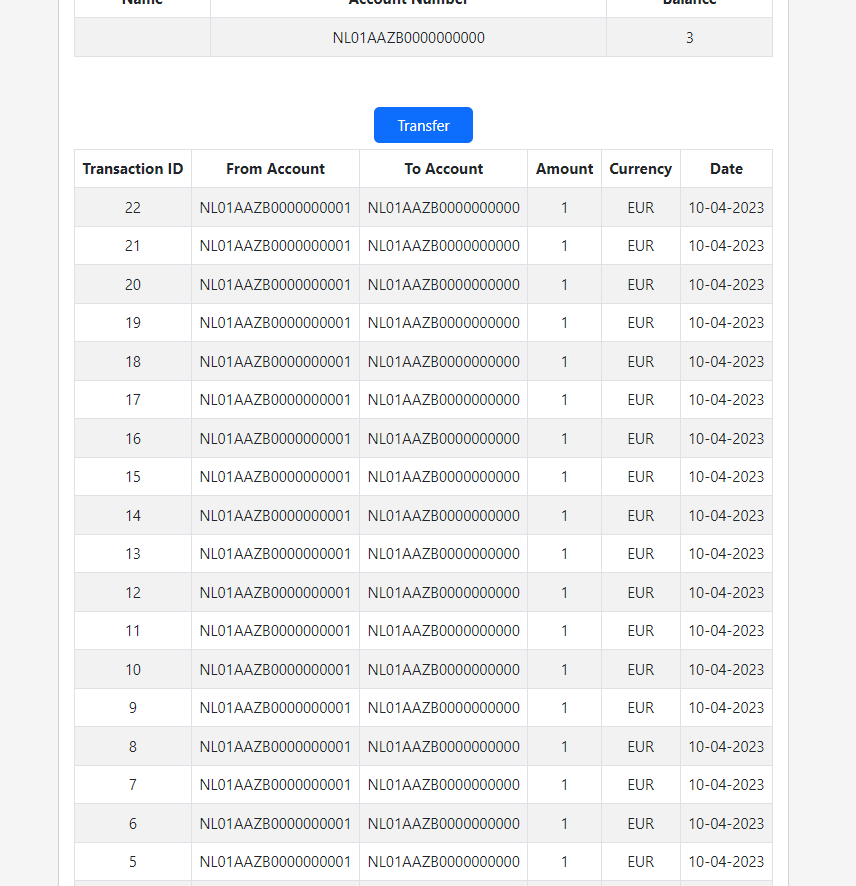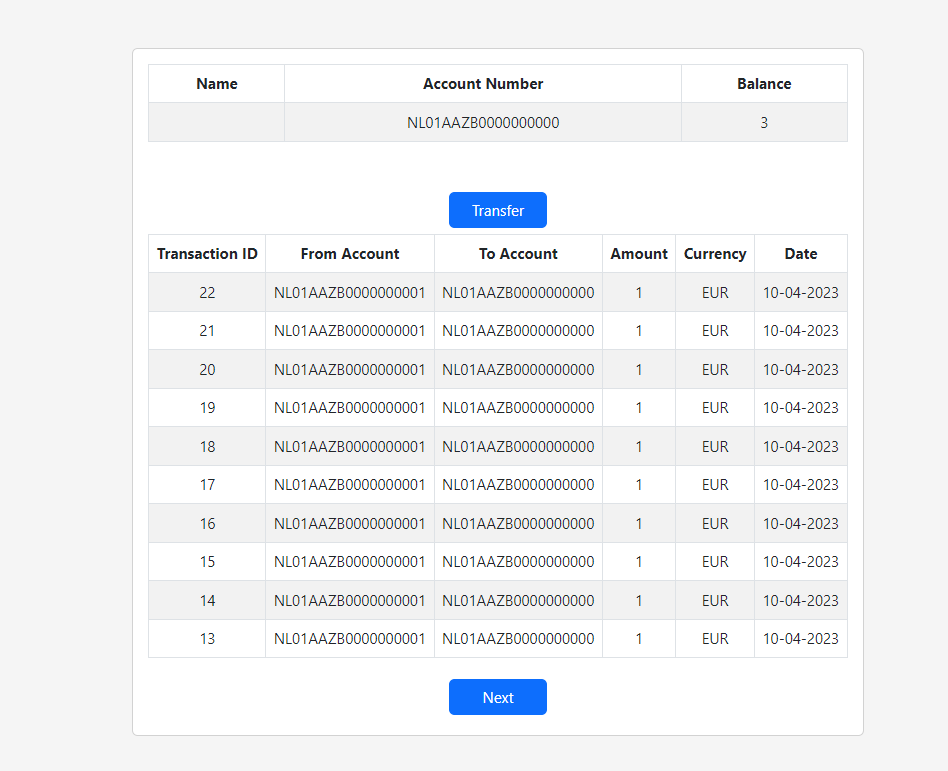Part 11: Pagination
Adding Pagination
All the functionality is there, but if you’ve been playing with it a bit you may have noticed something. The more transactions you send, your screen will fill up:
This is of course quite ugly, we’ll have to change this. For this we’ll add Pagination. Simply said, Pagination is when you cut up your big list, and show it in a user-friendly format.
We’ll have to change some things. First we’ll go to our Config.py file where we’ll add a new variable to denote how many tx we will want to see at once.
backend/config.py
...
class Config(object):
SQLALCHEMY_DATABASE_URI = os.environ.get('DATABASE_URL') or \
'sqlite:///' + os.path.join(basedir, 'app.db')
SQLALCHEMY_TRACK_MODIFICATIONS = False
SIGNUP_BONUS = {
'active': True,
'amount': 20
}
TX_PER_PAGE = 10
Great. We will further continue with the backend.
Pagination Backend
In our main/routes.py file we will add the following code:
backend/bank/main/routes.py
...
def gen_pagination_dict(
has_prev,
items,
has_next
):
return {
'has_prev': has_prev,
'items': items,
'has_next': has_next
}
def get_paginated_object(sqlalchemy_obj):
paginates = []
num_pages = sqlalchemy_obj.paginate(
page = 1,
per_page = Config.TX_PER_PAGE
).pages
for page_num in range(1, num_pages + 1):
page = sqlalchemy_obj.paginate(
page = page_num,
per_page = Config.TX_PER_PAGE
)
paginate = gen_pagination_dict(
page.has_prev,
[get_dict_from_object(tx) for tx in page.items],
page.has_next
)
paginates.append(paginate)
return paginates
def fetch_transactions(account_number):
...
txs_raw = tx_query.all()
if len(txs_raw) == 0:
return False, []
else:
paginated_txs = get_paginated_object(tx_query)
return True, paginated_txs
def get_overview(user):
...
tx_table = gen_result_dict(
tx_exists = tx_exists,
txs = txs,
page = 0
)
)
...
What happens here is that we split up our big list of dictionaries (transactions) into a list with pages. Each page is a dictionary which will contain three items: whether there is a next page, a previous page, and the list of transactions on that page. We make use of the SQLAlchemy functionality where we can paginate a query, where it will show us how many pages there are given our TX_PER_PAGE configuration. For each page it will then add the dictionary with the relevant information. Our result is a list with pages, where each page is a dictionary with has_prev (bool), a certain number of transactions (list), and has_next (bool). We will return this value to the frontend, where it can cycle through the pages.
In our Overview we change:
frontend/src/subcomponents/main/Overview.js
...
<tbody>
{txTable.tx_exists
?
txTable.txs[txTable.page].items.map((tx) => (
<tr>
<td>{tx.id}</td>
<td>{tx.to_account}</td>
<td>{tx.from_account}</td>
<td>{tx.amount}</td>
<td>{tx.currency}</td>
<td>{tx.date}</td>
</tr>
)
)
:
...
So we now pick the nth element of the list (with n denoted by the page) and render the items of it (the transactions).
We now see the top 10:
A good start, but we still need to be able to cycle through the pages. For that we have to add a new component, which we will do in our Overview.js file:
frontend/src/subcomponents/main/Overview.js
class PaginationButtons extends Component {
render () {
let txTable = this.props.state.txTable
return (
<>
{txTable.txs[txTable.page]['has_prev']
?
<Button
variant="primary"
>Previous
</Button>
:
null
}
{txTable.txs[txTable.page]['has_next']
?
<Button
variant="primary"
>Next
</Button>
:
null
}
</>
)
}
}
...
Here we have a new Component, which checks for that page that is being displayed whether there is a previous page, if there is it renders a button, else it doesn’t show. The same goes for Next. Very nice, now we add that to our Overview:
frontend/src/subcomponents/main/Overview.js
...
class TransactionTable extends Component {
render () {
let txTable = this.props.state.txTable
return (
<>
<Table striped bordered hover>
...
</Table>
{txTable['tx_exists']
?
<Pagination
txTable = {txTable}
onNavigatePagination = {this.props.onNavigatePagination}
/>
:
<>
</>
}
</>
)
}
}
...
We added some logic, where Pagination will only show up if there are any transactions at all. Otherwise it is unnecessary of course.
Nice, if you move back to the app you can now see a button in the bottom:
It doesn’t work yet thought. Clicking it does nothing Let’s change that. For that we add a method to our App component:
frontend/src/App.js
...
onNavigatePagination = (value) => {
let page = this.state.txTable.page
if (value === 'Next') {
this.setState({
txTable: {
...this.state.txTable,
page: page + 1
}
})
} else {
this.setState({
txTable: {
...this.state.txTable,
page: page - 1
}
})
}
}
...
Every time the button is clicked, it will change the state depending on the value, it will either add 1 to the page if the value is next, or else subtract 1. So when ‘Next’ is clicked, it will add 1 to the page, meaning that the page after that is rendered (if there is one). Similar with Previous.
And of course, all the components that use it have to intherit it:
frontend/src/App.js
...
class App extends Component {
render() {
...
{this.state.route === 'overview'
?
<Overview
state = {this.state}
onRouteChange = {this.onRouteChange}
onNavigatePagination = {this.onNavigatePagination}
/>
...
and in Overview.js
frontend/src/subcomponents/main/Overview.js
...
class Overview extends Component {
render () {
return (
<>
...
<TransactionTable
state = {this.props.state}
onNavigatePagination = {this.props.onNavigatePagination}
/>
...
class TransactionTable extends Component {
render () {
...
<Pagination
txTable = {txTable}
onNavigatePagination = {this.props.onNavigatePagination}
/>
...
class Pagination extends Component {
render () {
let txTable = this.props.txTable
return (
<>
{txTable.txs[txTable.page]['has_prev']
?
<Button
variant="primary"
onClick = {() => this.props.onNavigatePagination('Previous')}
>Previous
</Button>
:
null
}
{txTable.txs[txTable.page]['has_next']
?
<Button
variant="primary"
onClick = {() => this.props.onNavigatePagination('Next')}
>Next
</Button>
:
null
}
</>
)
}
}
...
Great, pagination now works! You can toggle between the pages by clicking Next and Previous. Try it!
Well done! We have now built a bank!



